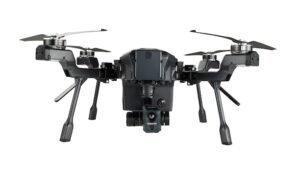 It’s been a good year for drone buyers. This year has seen new releases from drone manufacturers worldwide – and a couple of new entries. One of those, the SIRAS, comes from well-respected imaging company Teledyne FLIR.
It’s been a good year for drone buyers. This year has seen new releases from drone manufacturers worldwide – and a couple of new entries. One of those, the SIRAS, comes from well-respected imaging company Teledyne FLIR.
Continue reading below, or listen:
As commercial and public safety operations scale, FLIR cameras have been the thermal sensor of choice for drone operators around the world. With SIRAS, public safety and commercial operators have an aerial platform designed to compete with Chinese manufacturers on functionality and price while offering data security (SDK card only), no geofencing, and a U.S.-based development and customer service organization.
The SIRAS has hit the market as public safety and government organizations face increasing pressure to lessen their reliance on Chinese platforms, demonstrated by the recent ban in Florida. While the drone was designed specifically to meet the needs FLIR’s widespread customer base of drone operators, what do pilots think of SIRAS after 100 days of heavy use?
Pilots at Florida Drone Supply, a leading reseller of aircraft from a wide variety of manufacturers, provide their insights on the platform: the pros, the cons, and the upshot of purchasing a SIRAS.
The Pros
“We’ve been so excited about this drone as an alternative to DJI in Florida,” says Chris of Florida Drone Supply. Pilots flying the SIRAS say that the aircraft has a lot of positive points: battery life, imaging, IP rating, ease of use, swappable payload, and – last but not least – the price.
As a Fortune 500 imaging company, customers expect that a Teledyne FLIR drone will provide great sensors, and they won’t be disappointed. “The FLIR Boson®… camera is the star of the show,” Chris says.
SIRAS features a Vue® TV128 payload with FLIR’s patented MSX technology, which adds visible-light outlines to thermal imagery, making the data easier to understand. “The visible 16MP resolution camera zooms up to 128x to pinpoint details, offering 30 percent more pixels on target at max zoom in comparison to the leading China-based brand,” says Teledyne FLIR. “A companion 640×512-pixel, radiometric FLIR Boson provides sharp thermal imagery, 5x digital zoom, and accurate temperature-measurement.”
The SIRAS’ swappable payload system and the ability to remove the camera means that pilots will be able to make use of future payload options, which Florida Drone Supply says is “a big win, and a big selling point.”
Pilots say SIRAS lives up to its IP54 rating proving its resilience in all kinds of conditions including dust and water spray. Teledyne FLIR advertises a 31 minute battery life, and Florida Drone Supply confirms that’s pretty accurate: their average battery life is close to 30 minutes.
Is the SIRAS easy to fly? While Chris says that flight is “relatively easy,” he also points out that SIRAS is a pilot’s drone, which may require a little more input than a DJI.
Finally, at a price point less than $10,000, SIRAS is a solid, cost-effective solution. “The closest competitor is more than $4,500 more,” says Florida Drone Supply.
The Cons
Any aircraft comes with drawbacks, and pilots found that the SIRAS had a few quirks that users may need to get used to.
Pilots say that while the SIRAS is generally well built, the battery latch on the back presents a potential failure point – users need to be careful not to go past the center point, or the latch will break. While on the subject of battery, the Florida Drone Supply pilots would have preferred a universal fit battery, rather than one with a designated top and bottom. Users also recommend that buyers use care when putting the drone away: break the drone down every time and place it into the soft backpack correctly to protect it.
Additionally, Chris at Florida Drone Supply commented that pilots can’t fly and charge the remote controller battery at the same time, which may be inconvenient.
After extensive flight experience, the biggest caution that pilots offer with the SIRAS is in the landing: unlike other drones which slow way down before landing, the SIRAS can come it at full speed until it is within a few feet of the ground. Florida Drone Supply cautions users to take it slowly until they’re accustomed to the drone.
The Upshot
The pros far outweigh the cons as far as these commercial pilots are concerned, with the SIRAS stacking up well against competitors. “This is a fantastic drone,” says Chris. “We love it, we fly it nearly every day.”
SIRAS is still new to the market, and Teledyne FLIR is rapidly developing new payloads and accessories, which combined with the swappable payload system could make the aircraft even more versatile. “We see a bright future for this drone,” Chris says.
See the Florida Drone Supply summary here:
Read more:
Miriam McNabb is the Editor-in-Chief of DRONELIFE and CEO of JobForDrones, a professional drone services marketplace, and a fascinated observer of the emerging drone industry and the regulatory environment for drones. Miriam has penned over 3,000 articles focused on the commercial drone space and is an international speaker and recognized figure in the industry. Miriam has a degree from the University of Chicago and over 20 years of experience in high tech sales and marketing for new technologies.
For drone industry consulting or writing, Email Miriam.
TWITTER:@spaldingbarker
Subscribe to DroneLife here.
https://dronelife.com/2023/04/14/florida-drone-supplys-3-month-review-of-teledyne-flirs-siras-the-pros-the-cons-and-the-upshot/
 Unmanned Aerial Vehicle The latest drone news
Unmanned Aerial Vehicle The latest drone news



